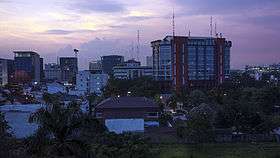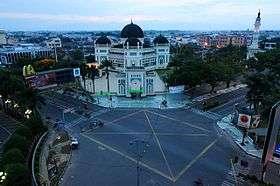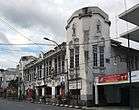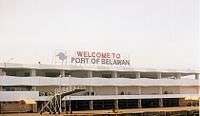Medan
| Medan Medan-Deli | |||||||
|---|---|---|---|---|---|---|---|
| City | |||||||
| Other transcription(s) | |||||||
| • Jawi | ميدن | ||||||
| • Chinese | 棉兰 | ||||||
| • Pinyin | Mián lán | ||||||
From top left to right: Medan city centre, Medan Great Mosque, Maha Vihara Maitreya, Maimoon Palace and various old buildings around Jalan Kesawan. | |||||||
| |||||||
| Nickname(s): Parijs Van Sumatra, Malay-Deli City | |||||||
|
Motto: Bekerja sama dan sama-sama bekerja (Working together and everybody work) | |||||||
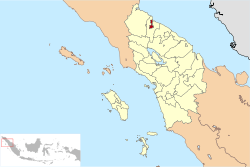 Location of Medan | |||||||
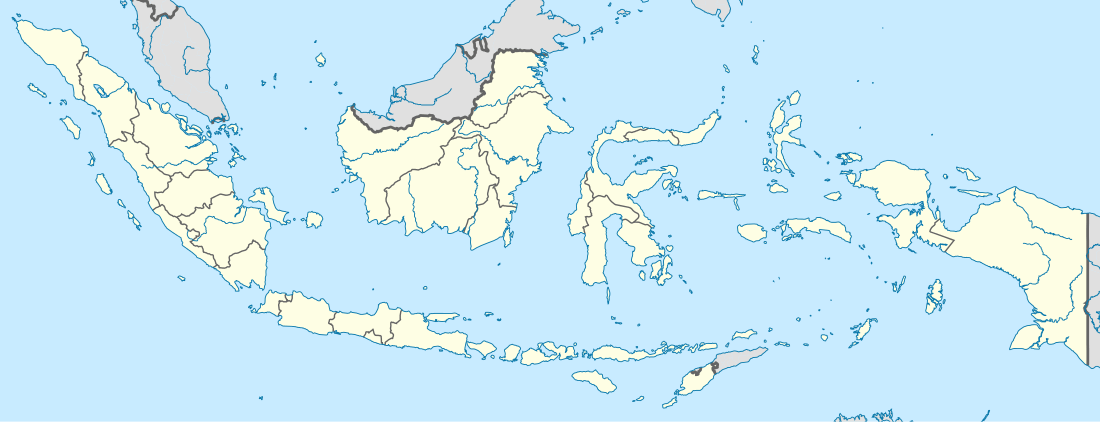 Medan Location of Medan | |||||||
| Coordinates: 3°35′N 98°40′E / 3.583°N 98.667°ECoordinates: 3°35′N 98°40′E / 3.583°N 98.667°E | |||||||
| Country | Indonesia | ||||||
| Province | North Sumatra | ||||||
| Founded | 1 July 1590 | ||||||
| Government | |||||||
| • Mayor | Dzulmi Eldin[1] | ||||||
| • Vice Mayor | Akhyar Nasution | ||||||
| Area | |||||||
| • City | 265.10 km2 (102.36 sq mi) | ||||||
| • Metro | 1,991.1 km2 (768.8 sq mi) | ||||||
| Elevation | 2.5–37.5 m (8–123 ft) | ||||||
| Population (2010 census) | |||||||
| • City | 2,097,610 | ||||||
| • Density | 7,900/km2 (20,000/sq mi) | ||||||
| • Urban | 2,046,973 | ||||||
| • Metro | 4,103,696 | ||||||
| • Metro density | 2,100/km2 (5,300/sq mi) | ||||||
| Time zone | WIB (UTC+7) | ||||||
| Area code(s) | +62 61 | ||||||
| Vehicle registration | BK | ||||||
| Website | Official Government Website | ||||||
| Medan | |||||||||||||||
| Traditional Chinese | 棉蘭 | ||||||||||||||
|---|---|---|---|---|---|---|---|---|---|---|---|---|---|---|---|
| Simplified Chinese | 棉兰 | ||||||||||||||
| |||||||||||||||
Medan (Indonesian pronunciation: [meˈdan]; Indonesian: Kota Medan) is the capital of North Sumatra province in Indonesia. Located on the northern coast, and with 2,097,610 inhabitants at the 2010 census, Medan is third largest city in Indonesia (behind Jakarta and Surabaya), and the largest Indonesian city outside Java.[2][3][4] Its built-up (or metro) area made of 18 municipalities or districts was home to 4,103,696 inhabitants at the 2010 census.[5] The city is bordered by the Deli Serdang Regency to the east, south and west, and the Strait of Malacca to the north.
The city was known as Deli when it was established by Dutch tobacco commerce after the formation of the Deli Company. The Deli Railway was established for shipping. Rubber, tea, timber, palm oil, and sugar industries followed.
Medan was dubbed by the Dutch Parijs van Soematra due to the city's resemblance to Paris. Lamudi, a worldwide real estate portal, recognized Medan as one among six cities in Asia to feature and preserve several colonial architectural sites, while accompanying its growth as a metropolitan city.[6]
Etymology
According to the diary of a Portuguese merchant in the early 16th century, the name of Medan was actually derived from Medina, which is the holiest city in Saudi Arabia, known as Midan (Arabic: ميدان). However, other sources indicate that the name of Medan actually came from the Indian Hindi language word "Maidan" (Hindi: मैदान) meaning "ground" or "land" . One of the Karo-Indonesia dictionaries written by Darwin Prinst SH published in 2002 stated that Medan could also be defined as "recover" or "be better".
History
In ancient times the city of Medan was known as Kampung Medan (Medan Village). It was a piece of swampy land with an area of approximately 4000 ha. Some of the rivers crossing the city of Medan drain into the Straits of Malacca. These rivers are Sei Deli, Sei Babura, Sei Sikambing, Sei Denai, Sei Putih, Sei Percut and Muara Belawan.
Founding of Medan
Medan started as a village called Kampung Medan (Medan Village). Kampung Medan was founded by Guru Patimpus Sembiring Pelawi, a Karonese man who came from the Karo Land. Before he became a Muslim, he was a Perbegu follower. Following the history of "trombo" and Hamparan Perak (XII Kuta), Guru Patimpus studied Islam Religion from Datuk Kota Bangun. At the time, Guru Patimpus and his people wanted to meet Datuk Kota Bangun. Not only did they want to meet Datuk Kota Bangun, they also wanted to compete with him for power. Whenever Guru Patimpus went to Bangun City, he always passed Pulo Brayan. In Pulo Brayan, Guru Patimpus fell in loved with the Princess of Pulo Brayan King. Eventually, he married the princess and had two sons, Kolok and Kecik. After he got married, Guru Patimpus and his wife turned the forest area between Deli and Babura river into a small village and it was called Medan. The date when that happened has been marked as the date of Medan Anniversary. It happened in July, 1st 1590.[7]
Deli Sultanate

In the 16th century there was a kingdom called Aru, with its center located where Deli Tua is now (South of Medan ). In 1612 the Acehnese Sultan Iskandar Muda defeated Aru. The Acehnese appointed Hisyamsudin (later he changed his name to Gocah Pahlawan) as their representative in this kingdom of East Sumatra. In 1632 Aceh established the Deli Kingdom (Kesultanan Deli; کسلطانن دلي) and Tuanku Panglima Gocah Pahlawan became the first king. He died in 1669 and was followed by Marhum Kesawan who moved the center of the kingdom to the present location of Medan. The third king, Tuanku Panglima Padrap, (ruled 1698–1728) moved the kingdom to Pulo Brayan. The fourth king, Tuanku Panglima Pasutan, (ruled between 1728–1761) moved the kingdom to Labuhan Deli. He organized the kingdom in four tribes, each led by a Datuk (a Malay title for high ranking persons). The fifth king, Tuanku Panglima Gandar Wahib, ruled in the period 1761–1805. During his time the Datuks increased their power.
The sixth ruler was Sultan Amaluddin Mengedar Alam, (ruled 1805–1850). The Siak Kingdom, during his years, became a stronger influence in Deli than the Acehnese Sultanate. The king was given the title Sultan. Sultan Osman Perkasa Alam ruled from 1850 to 1858. During his leadership the Deli sultanate became autonomous. Sultan Mahmud Al Rasyid Perkasa Alam (ruled 1858–1873) started the relationship with the Dutch, a relationship that became rather intimate. Sultan Ma’mun Al Rasyid Perkasa Alamsyah ruled from 1873 to 1924 when the tobacco trade expanded. He moved the kingdom to Medan and finished the construction of the Maimun Palace in 1888. He also built the grand mosque Al Ma'shun (Great Mosque of Medan) in 1907. He became known as the builder. Sultan Amaluddin Al Sani Perkasa Alamsyah (ruled 1924–1945) built harbors and commerce increased during this period. At the declaration of Indonesian Independence the Sultan recognized the sovereignty of the republic and was in return given an important function as administrator of Deli-Malay traditions and culture.
Dutch East Indies Era
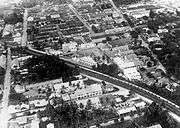
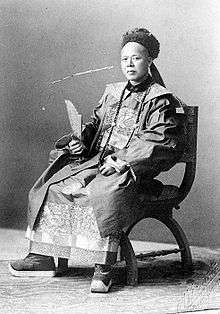

The opening of the Suez Canal in 1869 meant strongly intensified traffic between Europe and the Far East. The Dutch started the shipping company Stoomvaart Maatschappij Nederland that quickly expanded to 43 steamships in 1877. The English, however, had already 3,000 ships in those days. A journey from Europe to Indonesia took approximately 40 days. Genoa, Italy became the new transit harbor for passenger ships after the opening of the Gotthard Tunnel in Switzerland. The journey was reduced to 23 days and 20 hours to Batavia (Jakarta). The ships also became bigger and more comfortable.
Those things cause many cruise ships that carry tourists with a predominance of white European origin came to Dutch East Indies for a tour, including Medan as the largest tobacco plantation in Dutch East Indies at that time. To accommodate the tourists, it is very necessary to have European-class hotels. Therefore, in 1898, a Dutch businessman named Aeint Herman de Boer built Hotel de Boer in the northwest of the Esplanade (now Lapangan Merdeka Medan).
Exports were very dependent on British shipping in 1890 when Sabang became a bunker harbor. Belawan got its harbor in 1923. The shipping company Koninklijke Paketvaart Maatschappij (KPM) was established for the purpose of shipping valuable Deli Company tobacco, which was shipped to Batavia. This cargo was almost as valuable and stringent rules regulated its handling. It was strictly forbidden to stow anything on top of the tobacco and coolies were not even to walk on it when they worked in the hatches.[8]
Cleaning of roads in Medan was, until 1912, done by prisoners. After that free coolies got the job. In 1917 the authorities started to use horse-drawn carts, equipped with brooms for the cleaning. In 1928 the horse-drawn carts were replaced by motorized vehicles. The first newspaper was the ‘Deli Courant’, established in 1885. It did not appear daily. In 1898, Joseph Hallermann, a German, established the daily ‘De Sumatra Post’, which survived until 1939.
There were planters in Medan from many countries: England, the Netherlands, USA, France, Germany, Poland, and Switzerland. Many of them became very rich and led an affluent lifestyle. Medan became known as the Paris of Sumatra. Up till today, the area in downtown where the old airport is located is called Polonia, a name given by a Polish aristocrat who once owned a plantation here. One area of Medan is still called Helvetia (the old name of Switzerland). This name was given by a plantation owner from Switzerland.
Japanese Occupation and Post independence Era

The Japanese invasion began on 1942 throughout Indonesia. The Japanese troops who landed in Sumatra were XXV soldiers who were based in Shonanto which is currently known as Singapore, they landed on the 11 and 12 March 1942. The force was made up of Guard Division 2nd Empire coupled with the 18th Division led by Lieutenant Nishimura. They landed in four locations: Sabang, Ulele, Kuala Bugak (near Perlak, Aceh now) and Tanjung Tiram (Batubara region now). The Tanjung Tiram troops were the soldiers who went to the city of Medan, they rode bikes that they bought from the locals, and the Japanese troops occupied Medan until 1945.
After the Independence of Indonesia on 17 August 1945, Medan has been become the busiest city outside of Java. In 1947, Medan became the capital of East Sumatra with Tengku Mansur as State Mayor. After the RIS era ended, Medan officially became the capital of North Sumatra.
Geography
Medan is in the northeastern part of Sumatra island, in Sumatera Utara province. Medan lies on the banks of the Deli River and Babura River which feed into a naturally sheltered harbor and then into the Straits of Malacca, it has helped the city grow in significance as a trading port.[9] Its elevation varies between 2.5 and 37.5 metres (8 ft 2 in and 123 ft 0 in) above sea level. Medan is close to the Barisan Mountains which is located in the southern part of the city and close to volcanoes such as Sibayak Mountain and Sinabung Mountain (located as far as 50 to 70 kilometres (31 to 43 miles) from the city).
Located in the central part of Deli Serdang Regency, Medan is surrounded by satellite cities and towns such as Binjai, Lubuk Pakam, Tanjung Morawa, Tembung, Percut Sei Tuan, and Labuhan Deli which help the city become a new urban area in Indonesia which known as 'Mebidang' (Medan, Binjai, Deli Serdang)
Governance

Mayor
Medan was governed by mayor Dr. H. Abdillah Ak, MBA (appointed for the period 2005–2010). However, Abdillah and his vice mayor were caught by Indonesian Corruption Eradication Commission officials in 2008. Syamsul Arifin, the Governor of North Sumatra Province, then appointed Affifudin Lubis to become the acting mayor. In 2009, Affifudin Lubis resigned as mayor and the Governor then appointed Rahudman Harahap as mayor. Because Rahudman wanted to be a candidate in the 2010 mayor election, he too resigned from the office. Then Syamsul Arifin himself became the acting mayor. In the 2010 mayor election, Rahudman Harahap won the election. Rahudman was arrested due to corruption which result in his deputy Dzulmi Eldin officially became the acting mayor.[10]
Administrative division
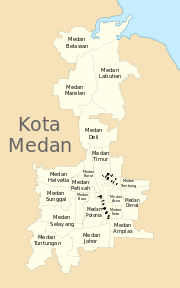
Medan is divided into 21 districts (Indonesian: kecamatan), tabulated below, and sub-divided into 151 neighborhoods or villages (kelurahan):[11][12]
- Medan Amplas
- Medan Area
- West Medan
- Medan Baru
- Medan Belawan
- Medan Deli
- Medan Denai
- Medan Helvetia
- Medan Johor
- Medan Kota
- Medan Labuhan
- Medan Maimun
- Medan Marelan
- Medan Perjuangan
- Medan Petisah
- Medan Polonia
- Medan Selayang
- Medan Sunggal
- Medan Tembung
- East Medan
- Medan Tuntungan
Based on the map, the city are centralised around Medan Petisah, Medan Baru, Medan Polonia, Medan Maimun, Medan Kota, and West Medan which is act as City Center. Medan Labuhan is one of the largest districts by area other than Medan Belawan and Medan Marelan which is lies on the northern part of the city. Medan Tuntungan serves as the gateway to Karoland regency, Medan Helvetia to Binjai City and Langkat and Medan Amplas to Tebing Tinggi and Pematang Siantar.
Demography
The city is Indonesia's fourth most populous after Jakarta, Surabaya, and Bandung, as well as Indonesia's largest city outside of Java island. The population has risen from 568,000 in 1968[13] fourfold to 2.1 million in 2010. Much of the population lies outside its city limits, especially in Deli Serdang Regency. The official Metropolitan area (Wilayah Metropolitan Medan) inhabited by 4,144,583 people in 2010.
Javanese, Batak, and Chinese are the major ethnics in Medan, with sizeable Mandailing, Minangkabau, Malay, and Karonese people and also has small Acehnese, Indians, Nias, and Sundanese community. Medan also has foreign residents from India, Sri Lanka Bangladesh, Thailand, China, Taiwan, Middle East and other Asian countries.[14]
| Administrative division | Area (km²) | Population (2010 Census) | Population (2015 Est) | Population density (/km²) |
|---|---|---|---|---|
| Medan (City) | 265.10 | 2,109,330 | 2,210,624 | 8,339 |
| Binjai (City) | 90.24 | 246,010 | 264,687 | 2,933 |
| Deli Serdang Regency | 2,384.62 | 1,789,243 | 2,029,308 | 851 |
| Greater Medan | 2,739.96 | 4,144,583 | 4,504,619 | 1,644 |
Source: BPS Sumut[15]
The city has diverse communities, reflected by its history. The Bataks is one of the major ethnic groups in Medan. In the past the Dutch employed them as workers in oil palm plantations. The Bataks reside throughout the city. The Mandailings also live here in large numbers and work in the most strategic government position. In addition, there is a large ethnic Javanese community, largely made up of the descendants of people transported from Java in the last century to be employed as contract workers at various plantations in North Sumatra. They are usually known as Pujakesuma (Putra Jawa Kelahiran Sumatera/Sumatra-born Javanese). Their presence in Medan can be marked from various Javanese toponymies in Medan, such as Harjosari, Sarirejo, Sidodadi, Sidomulyo, Sidorame, Sidorejo, Sitirejo, Sudirejo, Tanjungrejo, Tanjungsari, Tegalrejo, Tegalsari, etc. (mostly in East Medan and Medan Tembung area). The Malays and Karo peoples are the natives in Medan, already living in the city after the founding of Medan. The Malays living spread throughout the city, but they have a big concentration population in Medan Maimun, Medan Kota and Medan Area, meanwhile the Karo people mostly resided around Medan Selayang and Medan Tuntungan area.
A highly visible component of Medan's population is the large number of Chinese, the largest Chinese community in the Island of Sumatra, who are active in the business and trading activities. Almost all Chinese residents in Medan can speak fluent Hokkien, a dialect originating from Fujian Province in Southern China. Medan also has its own variation of Hokkien, known as Medan Hokkien (棉蘭福建話), the Chinese reside throughout the city. The Minangkabau also as merchants, peddlers, and artisans, in addition to as white collar, doctor, lawyer, and journalist. Minangkabaus living around Medan Denai and Medan Maimun area.[17] The city also host a sizable community of Tamil descendants who are commonly known as Madrasis or Tamilian. A well-known Tamil neighbourhood is Kampung Madras located on the city center, being one of the busiest part of the Medan town.
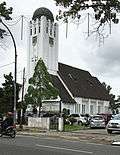 Immanuel Church, one of oldest church in Medan
Immanuel Church, one of oldest church in Medan Vihara Gunung Timur, the oldest Taoist temple in Sumatra Island
Vihara Gunung Timur, the oldest Taoist temple in Sumatra Island%2C_Medan.jpg) Sri Mariamman Temple, main Hindu temple in Medan
Sri Mariamman Temple, main Hindu temple in Medan
Climate
Under the Köppen climate classification, Medan features a tropical rainforest climate with no real dry season.[18] Medan does have noticeably wetter and drier months, with its driest month (February) on average seeing about one third of the precipitation of its wettest month (October). Temperatures in the city average approximately 27 degrees Celsius throughout the course of the year. Annual precipitation in the Medan is around 2200 mm.
| Climate data for Medan | |||||||||||||
|---|---|---|---|---|---|---|---|---|---|---|---|---|---|
| Month | Jan | Feb | Mar | Apr | May | Jun | Jul | Aug | Sep | Oct | Nov | Dec | Year |
| Average high °C (°F) | 31.6 (88.9) |
32 (90) |
32.7 (90.9) |
32.9 (91.2) |
33.4 (92.1) |
33.3 (91.9) |
32.9 (91.2) |
33.3 (91.9) |
31.9 (89.4) |
31.7 (89.1) |
31 (88) |
30.9 (87.6) |
32.3 (90.1) |
| Average low °C (°F) | 22.2 (72) |
22.6 (72.7) |
23.2 (73.8) |
23.5 (74.3) |
23.3 (73.9) |
23.6 (74.5) |
23.5 (74.3) |
22.8 (73) |
22.2 (72) |
22.6 (72.7) |
23 (73) |
22.5 (72.5) |
22.9 (73.2) |
| Average rainfall mm (inches) | 92 (3.62) |
115 (4.53) |
97 (3.82) |
157 (6.18) |
178 (7.01) |
141 (5.55) |
167 (6.57) |
185 (7.28) |
263 (10.35) |
387 (15.24) |
253 (9.96) |
228 (8.98) |
2,263 (89.09) |
| Average rainy days | 14 | 19 | 13 | 18 | 22 | 15 | 13 | 17 | 24 | 22 | 20 | 19 | 216 |
| Mean monthly sunshine hours | 96 | 106 | 111 | 105 | 111 | 144 | 124 | 108 | 78 | 74 | 84 | 84 | 1,225 |
| Source #1: World Meteorological Organization[19] | |||||||||||||
| Source #2: Deutscher Wetterdienst (sun, 1961–1990)[20][lower-alpha 1] | |||||||||||||
Culture
Medan is inhabited by many different ethnic groups, mostly Malay, Batak, Javanese, Padang, and Chinese. Malay people are the natives of the Medan area, and have deep roots in Medan. They began ruling there during the Deli empire (Kesultanan Deli) until now. The empire has many lands and property of heritage in Medan, such as Istana Maimoon, Mesjid Raya Medan, Sultan Deli Pool and many more.
The Javanese are transmigrants. Many of them were forced to move there by the government during transmigration programs.
Museum

The North Sumatra Museum is located approximately 4 kilometres (2.5 miles) to the south from the center of the city, which is in Jalan HM. Joni 15 Medan. The Minister of Education and Culture Dr. Daoed Joesoef opened north Sumatran museum in April 1982.This museum is open on: Tuesday – Thursday (08.00 – 16.00) Friday – Sunday (08.00 – 15.30) and Closed on: Monday. This museum gives a lot of information about ethnic and cultural which exists in North Sumatra, including history and stories of the museum. Some activities that can be done in this museum are: photographs and studying and learn about culture and the object of the North Sumatran history.
The Bukit Barisan Museum is a military museum opened by Brigade General Leo Lopulisa on June 21, 1971. This museum is located at 8 Jalan H. Zainul Arifin, Medan. It houses several historic weapons include weapons that were used in the struggle for independence and the revolt in North Sumatra during 1958. In this museum we could see several motives/ painting of the revolt against the Netherlands.[21]
Rahmat International Wildlife Museum & Gallery or more known as Rahmat Gallery, opened in 1999 and is chiefly the most incredible global taxidermy collection in the city, including various collections of wildlife, located on Jalan Letjen S. Parman no.309.[22]
Cuisine

Because of its multiculturality, Medan has wide variety of cuisine which originated from Malay, Bataknese, Chinese, Indian, Minangkabau, Javanese, Arabs, and Western cuisines.
This city is known as culinary heaven of Indonesia which prominent for its street hawkers offering a great variety of cuisine which often serves cheap local delicacies.
Merdeka Walk is the first Tensile Structure (Alfresco Outdoor Concept) in Indonesia, filled with a variety of cafés and restaurants.
Durian is a popular fruit in Indonesia and nowhere more so than in Medan. This thorny fruit, with its very distinctive taste and smell, is available for cheap all over the city.
Bika Ambon is a dessert from Indonesia. Made from ingredients such as tapioca flour, eggs, sugar, yeast and coconut milk, Bika Ambon are generally sold in pandan flavour, although other flavors such as banana, durian, cheese, chocolate are also available.
Dried fruits and many unique cuisines can be found in Pasar Rame, which operates every day from morning to afternoon, located just beside Thamrin Plaza.[23]
Tourism

Landmarks
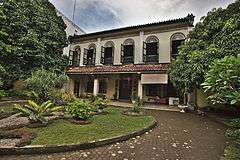
There are many old buildings in Medan that still retain their Dutch architecture. These include the old City Hall, the Medan Post Office, Inna Dharma Deli Hotel, Titi Gantung (a bridge over the railway), The London Sumatra building, Tjong A Fie Mansion, AVROS, Warenhuis, and The Tirtanadi Water Tower, mostly located around the old town Kesawan.
There are several historic places such as Maimoon Palace built in years 1887–1891, where the Sultan of Deli still lives (the Sultan no longer holds any official power), The Great Mosque of Medan built in 1906 in the Moroccan style by the Dutch architect A.J. Dingemans,.[24] both location of Maimoon Palace and The Great Mosque are close.The Mosque located on Jalan Sisingamangaraja and The Palace located on Jalan Brigjen Katamso.
Vihara Gunung Timur or locally known as Heng Hua Bio in hokkien, is a city's oldest Taoism temple, located on Jalan Hang Tuah. Medan has a Buddhist temple named as Maha Vihara Maitreya, and there is also a Buddhist centre nearby named as Maha Karuna Buddhist Centre (MKBC) this temple complex known as one of the biggest non-historical Buddhist temple in Indonesia, both situated around Cemara Asri housing complex. Medan Cathedral is the oldest church in the city, was built by the Dutch and Indian community nearby, and the church was named as Indische Kerk back then, located on the old town along Jalan Pemuda. Sri Mariamman Temple is the first Hindu temple in Medan built around 1881 by The Tamil peoples in the city, located on Jalan Zainul Arifin, The City's Little India or more known as Kampung Madras, the temple has unique south Indian architecture with hundred Hindu deity statues around the building.
Since 2005, a catholic church named Graha Maria Annai Velangkanni was built with an Indo-Mogul style, devoted to Mary, this particular Saint knows its origin with an apparition in the 17th century in Tamil Nadu, India. The temple has two stories and a small tower of seven storeys, it is situated on Jalan Sakura III, besides outer ring road on Jalan TB Simatupang.[25]
Shopping
Medan is one of the major shopping destinations of Indonesia, along with Jakarta and Bandung. It has several markets and shopping malls offering a wide range of goods and qualities. Some of the more popular markets for tourists include Pasar Rame (Rame Market) and Pasar Petisah (Petisah Market), which specialize in selling clothing and food; and the Pasar Ikan Lama (Old Fish Market), a marketplace for traditional Islamic wear and souvenirs of Medan. Some other marketplaces in the city are Pasar Beruang, Pasar Hong Kong, Pasar Sambas and Pasar Aksara.
Medan also has some modern malls. the newest and most popular among them are Sun Plaza, Medan Centre Point, Cambridge City Square, Medan Focal Point, Hermes Place Polonia and Plaza Medan Fair. The oldest malls are Thamrin Plaza, Medan Mall, Medan Plaza, Yang Lim Plaza, and Yuki Simpang Raya.
The upcoming malls in medan are Podomoro City Medan, Metrolink Trade Center, Ring Road City Walks, and The Manhattan.
Theme parks
There are some theme parks in the city or outside city, most of them are water park.
- HillPark GreenHill City – the latest theme park 1 hour from Medan on the way to Berastagi.
- Pantai Cermin Themepark – the first and only water theme park in North Sumatra, which located in Cermin Beach, Serdang Bedagai. The theme park is organized by Malaysia Investor and Local Government. Open on Mon, Wed, Thur and Fri (11.00 – 18.00) Sat, Sun and public holiday (09.00 – 18.00). Closed on Tuesday, except public holiday. With admission fee: Mon, Wed, Thur and Fri ->adult Rp 40,000,-child Rp 20.000,- (below 1,1 metre) and Sat, Sun and public holiday-adult Rp 60,000-child Rp 40,000,- (below 1,1 metre). Swimming, sun bathing and kayaking. To go there; rental car, private car or take mini bus (sudako) at Jalan. MT. Haryono (in front of Medan Mall) and stop at Perbaungan city. Then take a machine trishaw to the beach.
- Wonder Water World – latest waterpark in Medan, located on Central Business District (CBD) Polonia.
- Hairos Water Park – another waterpark near the city, located on jalan Djamin Ginting km.14, Deliserdang.
Transportation
Medan is well-connected by road, air, rail and sea. There are plenty of options for public transport within city and intercity.
Airport
The new Kualanamu International Airport (KNO) was opened to the public on July 25, 2013. The new airport is the second largest airport after Soekarno-Hatta International Airport with a 224,298 m2 (2,414,324 sq ft) passengers terminal and will eventually have a capacity of 50 million passengers (2030). It is the first airport in Indonesia which has direct rail links to the city. The airport is the hub for Garuda Indonesia, Indonesia AirAsia, Lion Air, Susi Air and Wings Air.[26] The new airport is a replacement for the Polonia Airport. Unlike the old Polonia Airport which was located in the heart of the city, this new airport is approximately 39 km (24 mi) from downtown. The airport has direct domestic flights to many major cities in Sumatra and Java. There are also some international flights to Malaysia, Singapore, Thailand, Saudi Arabia, Sri Lanka, etc. An airport train known as Airport Railink Services (ARS) connects the airport to city center. The train runs from Medan Main Station beside the Merdeka Square at Jalan Balai Kota from 4:00 a.m. to 08:00 p.m, and from the airport from 5:25 a.m. to 9:30 p.m. It is the fastest way to reach the airport from the city, taking 30 minutes. Alternate modes of transport from the airport into the city take longer (30 to 47 minutes).
Seaport
The Port of Belawan (Pelabuhan Belawan) is the main seaport in Medan. Located in the northeast coast of Sumatra, Belawan is situated 12 miles (19 km) north of Medan city and serves as a port, which is the terminus of a railway that crosses the channel south of the island by bridge.[27]
The port was initially built in 1890 to provide a location where tobacco could be transferred directly between rail lines from the interior and deep-draft ships. The harbor expanded in 1907 with the construction of a new section intended for Chinese and indigenous traders, reserving the existing port for European shipping. In the early twentieth century the port's business expanded, with the growth of major rubber and palm oil plantations in northern Sumatra. In the 1920s several major berthing facilities were built. In 1938, the port was the largest port in the Dutch East Indies, in terms of cargo value. Cargo volumes dropped substantially after Indonesian independence, and did not reach pre-independence levels again until the mid-1960s. A major restructuring in 1985 saw the construction of a container terminal; it almost immediately captured about one-fifth of Indonesia's containerized exports. Major products exported include rubber, palm oil, tea, and coffee.[28]
There are two port terminals, one for Passenger and Ferry Services to Penang and Langkawi and some Indonesian cities such as Batam, Jakarta, and Surabaya. another terminal known as Belawan International Container Terminal (BICT), used for export and importing services, BICT is one of the largest shipping industry port in Indonesia.
Road and highway
Medan is connected by the Trans-Sumatran Highway, the main road across Sumatra, and the Belawan-Medan-Tanjung Morawa Toll Road, also known as the Belmera Toll Road, the one and only available Toll Road in Medan, connecting Belawan, Medan and Tanjung Morawa. Currently there are additional toll roads under construction which will connect the city to the airport, Binjai, and Tebing Tinggi.
Rail
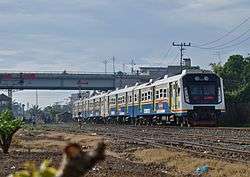
Railway lines connect Medan to Binjai and Tanjungpura to the northwest, to port of Belawan to the north, to Tebing Tinggi and Pematang Siantar to the southeast, and also Rantau Prapat among other cities. The largest train station in Medan is Medan Station. There are also smaller stations in Medan, such as Medan Pasar, Pulu Brayan, Titi Papan, and Labuhan, and Belawan. Titi Papan and Pulu Brayan only serve as the stop for freight trains carrying oil palm and petroleum. There are also have express train connecting to another North Sumatra cities such as Tebing Tinggi, Pematang Siantar, Tanjung Balai, and Rantau Prapat.
The Railink train is an airport express train connecting from CRS (City Railway Station) to ARS (Airport Railink Station).
Public transport
One of the unique features of Medan are the motorized rickshaws known as Becak Motor (Bentor) or Becak Mesin. The becaks are found almost everywhere. Unlike the Javanese rickshaws, the driver sits on the right side of the vehicle and unlike traditional becaks, a motorized becak can take its passenger anywhere in the city. The fare to ride a becak is relatively cheap and is usually negotiated beforehand.
There are also more public transport like taxis and minibuses, known as Sudako or Angkutan Kota (Angkot). The angkot can be found easily in medium-to-high congested roads, and angkots always use a route number.
TransMebidang is a new bus rapid transit system in North Sumatra, Indonesia that has 2 active corridors.
| Corridor # | Origin-Destination |
|---|---|
| 1 | Medan – Binjai |
| 2 | Medan – Lubuk Pakam |
Media
C.J. Kleingrothe photographed tobacco, coffee, tubber, and palm oil cultivation and infrastructure in Medan when it was part of the Dutch East Indies. The TVRI Medan (state-owned), SindoTV Medan, RTV Medan, and Deli TV (private) are the four local television stations in Medan. Medan also has twelve national television stations: Indosiar, MNCTV, Trans TV, ANTV, Global TV, RCTI, SCTV, TV One, Metro TV, Trans7, NET, and DAAI TV. Several national and local newspapers are running in the city with Harian Mimbar Umum as the oldest one. Other popular newspapers include Harian Waspada, Analisa, Kompas, Jurnal Medan, Berita Sore, Harian Global, Harian Medan Bisnis, Posmetro Medan, Suara Indonesia Baru, and "Tribun Medan". There are also has some mandarin language newspaper such as Harian Indonesia (印尼星洲日报), Guo Ji Ri Bao (国际日报) and Shangbao (印尼商报). English newspaper like The Jakarta Post also distributed in the city.
Sport
Football is one of the more popular sports in Medan, with five local clubs: PSMS Medan, Medan Jaya, Medan Chiefs, Bintang PSMS and Medan United; and a basketball club named Angsapura Sania. Another locally popular sport is Wushu, with significant growth in recent years as one of the favorite sports in Medan. It has its training center in Jalan Plaju in heart of town. Medan has recently seen much success in Wushu nationally and internationally. Medan has a multi-purpose stadium named Teladan Stadium. This stadium is used mostly for football matches, and serves as a home stadium for PSMS Medan.
Twin Towns – Sister cities
Medan has sister relationships with these cities: [29]
 George Town, Penang, Malaysia (1984)[29]
George Town, Penang, Malaysia (1984)[29]  Ichikawa, Chiba, Japan (1989)[29]
Ichikawa, Chiba, Japan (1989)[29] Gwangju, South Jeolla, South Korea (1997)[29][30]
Gwangju, South Jeolla, South Korea (1997)[29][30]  Chengdu, Sichuan, China (2002)[29]
Chengdu, Sichuan, China (2002)[29] Milwaukee, Wisconsin, United States (2014)[31]
Milwaukee, Wisconsin, United States (2014)[31] Liverpool, United Kingdom
Liverpool, United Kingdom
Gallery
- Gallery of panoramic and street view images from Medan
 Jalan Kesawan in the 1910s.
Jalan Kesawan in the 1910s.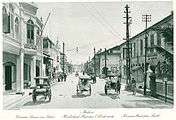 Another old view of Jalan Kesawan.
Another old view of Jalan Kesawan. Night street view of Medan.
Night street view of Medan.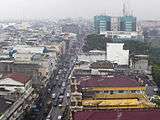 Cityscape around Jalan Irian Barat, Medan.
Cityscape around Jalan Irian Barat, Medan. Tirtanadi Tower.
Tirtanadi Tower.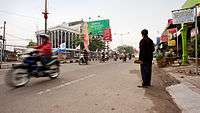 View of Jalan Sisingamaraja, Medan.
View of Jalan Sisingamaraja, Medan. Medan skyline, 2010.
Medan skyline, 2010. Another Medan skyline, 2012.
Another Medan skyline, 2012.
References
- ↑ "Eldin resmi jadi Walikota Medan". 2014-06-18. Retrieved 2015-03-10.
- ↑ "Indonesians torch US flag in protest in country's third-largest city". Fox News. 18 September 2012. Archived from the original on 23 August 2016. Retrieved 12 September 2016.
- ↑ http://swa.co.id/swa/trends/marketing/erafone-mega-store-tancapkan-kaki-di-kota-medan
- ↑ SWA 16th Edition : Indonesia Best Cities for Business 2016
- ↑ http://www.citypopulation.de/php/indonesia-sumatera-admin.php
- ↑ Feriawan Hidayat (March 29, 2015). "Enam Kota Asia Paling Trendi untuk Menetap".
- ↑ "Guru Patimpus: The Ancestor and Founder of Medan". iqbalrahdika. Retrieved 20 November 2014.
- ↑ History of Place History of Medan
- ↑ Usman Pelly, Sejarah Kota Madya Medan, 1950–1979; Departemen Pendidikan dan Kebudayaan R.I., Proyek Inventarisasi dan Dokumentasi Sejarah Nasional, Direktorat Sejarah dan Nilai Tradisional, 1985
- ↑ koran-indonesia.com KPK Arrests Mandailing Natal Mayor for Alleged Bribery
- ↑ http://www.pemkomedan.go.id Info Data Kota Medan
- ↑ http://www.bppt-pemkomedan.info Kondisi Geografis Medan
- ↑ Ensiklopedi Umum, Penerbitan Jajasan Kanisius, 1973
- ↑ Leo Suryadinata, Evi Nurvidya Arifin, Aris Ananta, Indonesia's Population: ethnicity and religion in a changing political landscape, Institute of Southeast Asian Studies, 2003.
- ↑ http://sumut.bps.go.id/frontend/linkTabelStatis/view/id/499 Jumlah Penduduk dan Rumah Tangga Menurut Kabupaten/Kota, 2015
- ↑ Indonesia's Population: Ethnicity and Religion in a Changing Political Landscape. Institute of Southeast Asian Studies. 2003. ISBN 9812302123
- ↑ Usman Pelly, Urbanisasi dan Adaptasi: Peranan Misi Budaya Minangkabau dan Mandailing, LP3ES, 1994
- ↑ "Medan, Indonesia Köppen Climate Classification (Weatherbase)". Weatherbase. Retrieved 4 July 2015.
- ↑ "World Weather Information Service–Medan". World Meteorological Organization. Retrieved June 18, 2015.
- ↑ "Station 96035: Kualanamu Medan". Global station data 1961–1990—Sunshine Duration. Deutscher Wetterdienst. Retrieved June 18, 2015.
- ↑ "North Sumatra Museum". Indonesia Tourism. Retrieved 19 November 2014.
- ↑ Gunawan, Apriadi (30 March 2011). "A glimpse of wildlife in Medan museum". The Jakarta Post. Archived from the original on 5 March 2016. Retrieved 8 September 2015.
- ↑ "Medan: Entry Point to North Sumatra". Indonesia.travel. Retrieved 19 November 2014.
- ↑ http://www.pac-nl.org/downloads/medanurbandevelopmentcp08.pdf
- ↑ Annai Velangkanni. "Marian Shrine Of Annai Velangkanni". Retrieved 4 July 2015.
- ↑ "All systems go for Medan". TTGmice. Retrieved 11 December 2012.
- ↑ "Belawan". britannica. Retrieved 19 November 2014.
- ↑ "Port of Medan/Belawan". seaport.homestad. Retrieved 19 November 2014.
- 1 2 3 4 5 "Medan Menjalin Hubungan Kota Kembar Keempat". Archived from the original on 23 April 2007. Retrieved September 10, 2013.
- ↑ "Sister Cities – General Information – Gwangju Info :: Welcome to Gwangju Metropolitan City". Retrieved 4 July 2015.
- ↑ "City will host Indonesian sister city signing ceremony Thursday" (online magazine, press release). onMilwaukee.com. 28 October 2014. Retrieved 2014-11-16.
Notes
- ↑ Station ID for Kualanamu Medan is 96035 Use this station ID to locate the sunshine duration
External links
| Wikimedia Commons has media related to Medan. |
 Medan travel guide from Wikivoyage
Medan travel guide from Wikivoyage- Official Government website (Indonesian)
- Medanesia – Medan Forum (Indonesian)
